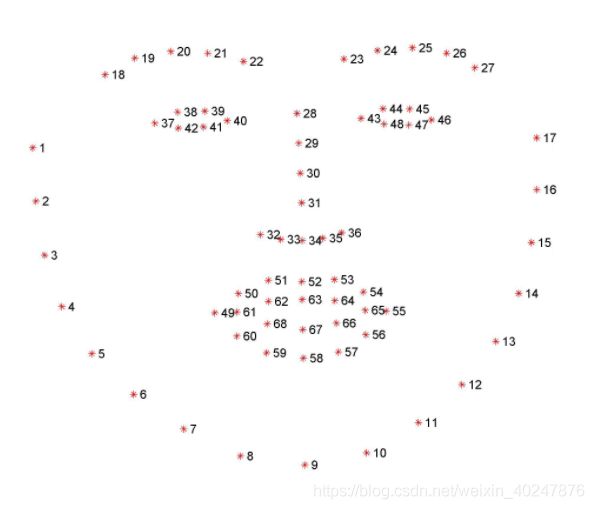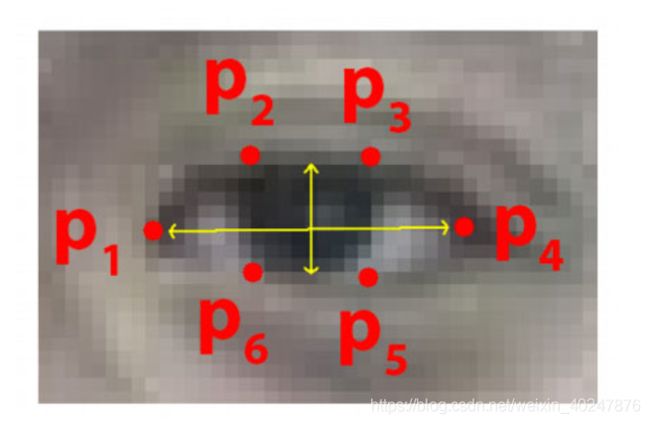OpenCV杂谈_10
一. 需要做的前期准备
- 环境配置:
Python版本:3.6.0(这里需要注意一下,如果你的python版本为>=3.9,对于dlib包的导入将会很困难,具体导入方法博主还没有解决)
功能包:scipy (1.5.4)、imutils (0.5.4)、argparse (1.4.0)、dlib (19.22.0)、opencv-python (4.5.2.54)
- 如果想要对录制好的视频进行处理则需要提前获得的视频
- 下载shape_predictor_68_face_landmarks.dat,作者把它传到了云盘里,需要的自取:链接在此 提取码:demo
- 一个用的顺手的IDE(本人推荐Pycharm)
二. 须知
- 68 points face landmark:

- 眼睛距离计算


三. 源码如下(闭眼检测)
import cv2
import dlib
from scipy.spatial import distance
def calculate_EAR(eye):
"""计算眼睛之间的距离"""
A = distance.euclidean(eye[1], eye[5])
B = distance.euclidean(eye[2], eye[4])
C = distance.euclidean(eye[0], eye[3])
ear_aspect_ratio = (A + B) / (2.0 * C)
return ear_aspect_ratio
cap = cv2.VideoCapture(0)
hog_face_detector = dlib.get_frontal_face_detector()
dlib_facelandmark = dlib.shape_predictor("shape_predictor_68_face_landmarks.dat")
while True:
_, frame = cap.read()
gray = cv2.cvtColor(frame, cv2.COLOR_BGR2GRAY)
faces = hog_face_detector(gray)
for face in faces:
face_landmarks = dlib_facelandmark(gray, face)
leftEye = []
rightEye = []
for n in range(36, 42):
x = face_landmarks.part(n).x
y = face_landmarks.part(n).y
leftEye.append((x, y))
next_point = n + 1
if n == 41:
next_point = 36
x2 = face_landmarks.part(next_point).x
y2 = face_landmarks.part(next_point).y
cv2.line(frame, (x, y), (x2, y2), (0, 255, 0), 1)
for n in range(42, 48):
x = face_landmarks.part(n).x
y = face_landmarks.part(n).y
rightEye.append((x, y))
next_point = n + 1
if n == 47:
next_point = 42
x2 = face_landmarks.part(next_point).x
y2 = face_landmarks.part(next_point).y
cv2.line(frame, (x, y), (x2, y2), (0, 255, 0), 1)
left_ear = calculate_EAR(leftEye)
right_ear = calculate_EAR(rightEye)
EAR = (left_ear + right_ear) / 2
EAR = round(EAR, 2)
if EAR < 0.26:
cv2.putText(frame, "WAKE UP", (20, 100),
cv2.FONT_HERSHEY_SIMPLEX, 3, (0, 0, 255), 4)
cv2.putText(frame, "Are you Sleepy?", (20, 400),
cv2.FONT_HERSHEY_SIMPLEX, 2, (0, 0, 255), 4)
print("!!!")
print(EAR)
cv2.imshow("Are you Sleepy", frame)
key = cv2.waitKey(1)
if key == 27:
break
cap.release()
cv2.destroyAllWindows()
四. 源码如下(眨眼次数计算,注释懒得写成中文了,自行理解)
from scipy.spatial import distance as dist
from imutils.video import FileVideoStream
from imutils.video import VideoStream
from imutils import face_utils
import imutils
import time
import dlib
import cv2
def eye_aspect_ratio(eye):
A = dist.euclidean(eye[1], eye[5])
B = dist.euclidean(eye[2], eye[4])
C = dist.euclidean(eye[0], eye[3])
ear = (A + B) / (2.0 * C)
return ear
p = 'shape_predictor_68_face_landmarks.dat'
v = "video.mp4"
EYE_AR_THRESH = 0.25
EYE_AR_CONSEC_FRAMES = 2
COUNTER = 0
TOTAL = 0
print("[INFO] loading facial landmark predictor...")
detector = dlib.get_frontal_face_detector()
predictor = dlib.shape_predictor(p)
(lStart, lEnd) = face_utils.FACIAL_LANDMARKS_IDXS["left_eye"]
(rStart, rEnd) = face_utils.FACIAL_LANDMARKS_IDXS["right_eye"]
print("[INFO] starting video stream thread...")
vs = VideoStream(src=0).start()
fileStream = False
time.sleep(1.0)
while True:
if fileStream and not vs.more():
break
frame = vs.read()
frame = imutils.resize(frame, width=450)
gray = cv2.cvtColor(frame, cv2.COLOR_BGR2GRAY)
rects = detector(gray, 0)
for rect in rects:
shape = predictor(gray, rect)
shape = face_utils.shape_to_np(shape)
leftEye = shape[lStart:lEnd]
rightEye = shape[rStart:rEnd]
leftEAR = eye_aspect_ratio(leftEye)
rightEAR = eye_aspect_ratio(rightEye)
ear = (leftEAR + rightEAR) / 2.0
leftEyeHull = cv2.convexHull(leftEye)
rightEyeHull = cv2.convexHull(rightEye)
cv2.drawContours(frame, [leftEyeHull], -1, (0, 255, 0), 1)
cv2.drawContours(frame, [rightEyeHull], -1, (0, 255, 0), 1)
if ear < EYE_AR_THRESH:
COUNTER += 1
else:
if COUNTER >= EYE_AR_CONSEC_FRAMES:
TOTAL += 1
COUNTER = 0
cv2.putText(frame, "Blinks: {}".format(TOTAL), (10, 30),
cv2.FONT_HERSHEY_SIMPLEX, 0.7, (0, 0, 255), 2)
cv2.putText(frame, "EAR: {:.2f}".format(ear), (300, 30),
cv2.FONT_HERSHEY_SIMPLEX, 0.7, (0, 0, 255), 2)
cv2.putText(frame, "COUNTER: {}".format(COUNTER), (140, 30),
cv2.FONT_HERSHEY_SIMPLEX, 0.7, (0, 0, 255), 2)
cv2.imshow("Frame", frame)
key = cv2.waitKey(1) & 0xFF
if key == ord("q"):
break
cv2.destroyAllWindows()
vs.stop()
五. 感悟与分享
- 有关闭眼检测的教程:https://www.youtube.com/watch?v=OCJSJ-anywc&t=305s&ab_channel=MisbahMohammed
- 有关眨眼次数计算的教程:https://www.pyimagesearch.com/2017/04/24/eye-blink-detection-opencv-python-dlib/
以上内容均为英文,且需要。
- 其实原理并不复杂,就是通过检测出眼睛,之后再计算眼皮之间的距离,来获得最终想要的数据。
如有问题,敬请指正。欢迎转载,但请注明出处。


